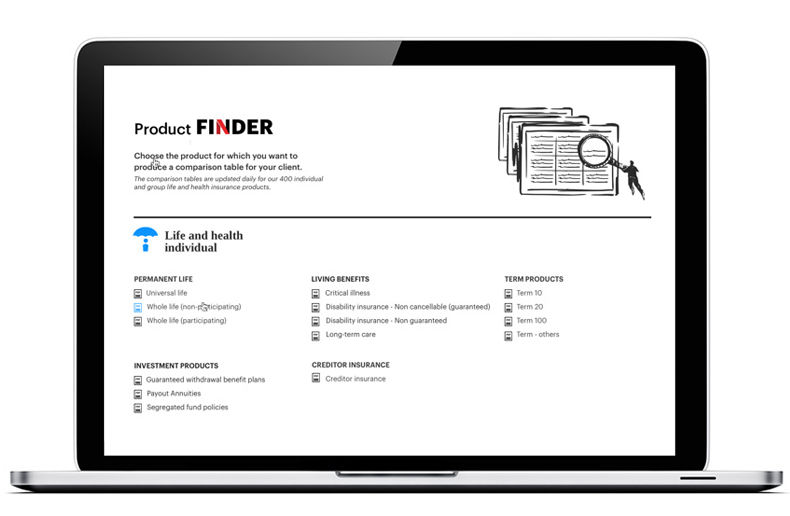Previously reserved for the hard to insure, simplified issue products have evolved into fully underwritten simplified products. Backed by artificial intelligence, these products have become an alternative to traditional simplified issue products.
Just a few years ago, issuing a life insurance policy could take weeks. Simplified issue products typically reduced wait times but at a higher price. These days, fully underwritten products can also step up the pace thanks to artificial intelligence, often at the same price as a traditional simplified issue product.
Pierre Vincent, Senior Vice-President, Individual Insurance and Sales, at iA Financial Group and President of iA Excellence, says that you need to distinguish simplified products based on a limited set of closed questions (traditional) and simplified products based on automation. “With automation, an inference engine consults databases in real time. This means that clients are asked only the questions that concern their condition,” he explains.
Simplified issue product underwriters select risks according to a list of static questions, he adds. “Based on the answers and on certain criteria, the insurer will determine the mortality risk. The price will be higher than that of a traditional product.”
Algorithm revolution
Algorithms are changing the game dramatically, Vincent says. iA is experimenting with its EVO and Assur & Go products, offered by iA Excellence.
“Our tools let us obtain information we can use to target the right questions for each client. So clients can purchase higher and higher insurance amounts through a simple process. Our product line lets a 50-year-old client purchase an insurance amount of $500,000 at an identical price to what it would cost based on a traditional complete underwriting process,” he says.
These fully underwritten products can make 55 per cent of the decisions at the point-of-sale. “The line between simplified issue and fully underwritten is constantly fading. Maybe in one or two years there won’t be a difference anymore.”
Vincent, an actuary by training, says that the insurer’s algorithm is constantly improving its decisions at point-of-sale. “It accepts insured at the point-of-sale or refers them to underwriting to get more details,” Vincent says. “If the algorithm declines the client, it says why. And if the client is willing to pay a higher premium we can say: here’s the risk and here’s what it will cost.” He says the insurer intends to continue to increase insurance limits and make the purchase process simpler.
Simplified products for the hard-to-insure are not backed by the same kind of technology. Yet they still have a firm grip on their market.
iA offers Access Life products, and Humania distributes four products in the Insurance Without Medical Exam (IWME) series: life, critical illness, debt and income. Both insurers say that their product lines are very successful.
Canada Protection Plan is also earning its bread and butter. With Foresters Financial as a risk taker, the MGA offers a spectrum of products ranging from guaranteed and deferred acceptance to fully underwritten products, including simplified insurance without a medical exam that can cover up to $500,000.
“In 20 years, we accumulated vast experience in this niche, which let us improve our offer,” says Pierre Vincent, of iA. “Many clients of these simplified issue products are people who are harder to insure. We also get healthy people who want a simple process for lower insurance amounts, for example, $100,000 to $250,000.”
Covering declined applicants
Humania Assurance CEO Stéphane Rochon points out that his company has operated in this niche for five years. The insurer says that it has granted some of the 5 to 6 per cent of Canadians declined by other insurers access to insurance, as well as 20 to 25 per cent of those declined for critical illness and disability insurance.
“Traditional simplified products, which deliberately ask fewer questions and take greater risk at a higher price, still have an important place,” Rochon explains. “The automated product HuGO cannot insure a client who had cancer two years earlier. IWME can. We may take the client even if the risk is aggravated because overall the client may not be that risky.”
To make the product even more accessible, starting in November the insurer plans to increase the age limit to 70 (currently 65) for life insurance, It will also expand the product offer, subject to certain conditions, to people who do not hold paid employment at the time of underwriting. “It is no small thing to increase age by five years and expand coverage to part-time workers,” Rochon says. “Before, the whole risk selection system was based on the fact that people worked full-time.”
Canada Protection Plan Regional Vice-President, Sales, Québec Centre, Alain Plante says that simplified issue products are miles ahead of the rate books used 20 years ago. This evolution has pushed the limits of acceptance, he said at an advisor education session held in Montreal organized by the Council of Professionals in Financial Services (CDPSF).
“Simplified issue insurance has ushered in a new technique: nonmedical pricing. It is based entirely on questions,” Plante explains. “If you answer yes you will be directed to a more restrictive product. If you answer no, you get a product with better conditions.”
Founded in 1992 by David Slabodkin, CPP compiles statistics that let it offer insurance “under any conditions,” Plante says. “The doctor will say that a person diagnosed with metastatic cancer has a life expectancy of six months to two years. It is impossible for these people to purchase traditional insurance,” he adds.
CPP’s data gives it a different perspective. “Our statistics tell us that many of these people will live beyond two years. We have a product that reflects this reality: Guaranteed Acceptance Life Insurance, with deferred coverage. Limited to $25,000 in life insurance, the insurer pays a benefit only if death occurs more than 24 months after the policy is issued,” Plante explains.
Someone who received a cancer diagnosis 13 years ago and has been in remission for 11 years has a chance to purchase a product with better conditions, he adds. “We ask people if they suffered from cancer in the last 10 years. Such clients could purchase Simplified Elite Life Insurance.”
The insurance coverage on this product is payable immediately in case of death. It also offers superior prices. “Someone who had a nonaggressive cancer and is considered in remission for five years can obtain up to $500,000 in life insurance coverage immediately,” Plante says.
He adds that someone in remission for three years can receive up to $350,000 in insurance with deferred coverage for only one year, and coverage of 50 per cent of the capital in the second year.




